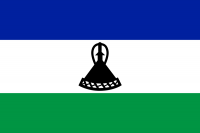Lesotho

The Kingdom of Lesotho is situated in the south eastern region of Southern Africa, covering an area of 30,355 km² and is entirely surrounded by South Africa. Lesotho’s geographical formation is characterised by high mountains and deep valleys, and it is the only country in the world to have all its entire territory located at more than 1,000 metres above sea level. More than 75 % of Lesotho is mountainous, with only 25 % considered lowland. The lowest point is 1,388 metres rising to almost 3,500 metres in the Maloti mountain range which forms the border with South Africa to the north east and south west.
Lesotho has a continental climate, with four distinct seasons and extremes of temperature. Spring is from August to October, summer extends from November to the end of January. Autumn, which runs from February to April, is harvest time in Lesotho and lastly winter months from May to July bring snow with dry, sunny days and cold nights. Temperatures do not get unbearably high, due to the altitude. Temperatures can drop as low as -10 °C.
The population of Lesotho is about 1,879,000 (2011). The vast majority of the population is Basotho with small groups of Europeans and Asians. Lesotho is inhabited by the Basotho people and the official languages are Sesotho and English. The capital is Maseru, with other major population centres being Mafeteng and Roma. In October 1966, Lesotho gained independence from British rule with King Moshoeshoe II appointed as its ruler. The democratic elections held in 2002 installed a new government focused on good governance, accountability, transparency, and the participation of people in the decisions that affect their lives. The King is the Head of State.
The manufacturing subsector, mainly driven by textile and clothing industries, has since 2001, dominated Lesotho’s exports destined mainly for the United States and South Africa. This sub-sector is the pillar of Lesotho’s economy, as a result, its deceleration had an adverse impact on the overall economy. The performance of the sector deteriorated, owing to the end of the Agreement on Textiles and Clothing in January 2005, which resulted in the closure of a number of textile firms. Nearly 85 % of Basotho households live in rural areas and about 70 % derive part of their income from agriculture. The construction sub-sector (the second largest contributor to real Gross Domestic Product (GDP) increased by 2.0 % in value-added in contrast to a 0.4 % rise recorded in 2004. In 2005, the tertiary sector was the main contributor to GDP at a share of 44.8 %. Mining sector is a marginal contributor to GDP, although Lesotho is believed to have significant mineral deposits including diamonds, uranium, base metal, high quality stone and clay.
The Lesotho Highlands are the country's main tourist attraction. Spectacular cliff formations and deep gorges are found in the Maloti and Drakensberg mountain ranges in the south of the country. The Maloti/ Drakensberg, a world heritage site, are home to some 2,500 species of plants and contain the world's richest concentrations of Stone Age rock art, with more than 30,000 individual paintings recorded. Landmarks in Lesotho include Mount Qilone, and Thaba Bosio, a fortress stronghold where the kings of Lesotho are traditionally buried. Thabana Ntlenyana, at 3,483 metres, is the highest mountain in Southern Africa, whilst Maletsunyane Falls is one of the tallest single-drop waterfalls in the region plunging for 192 metres and Sehlabe-Thebe National Park.













